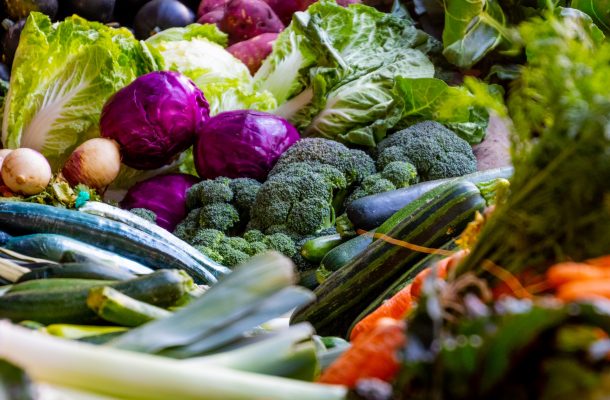Are greens better than pills to prevent falls for elderly people?

Just half a cup of broccoli a day can help older people avoid being hospitalised for a fall, new research from Edith Cowan University has found.
Researchers from the School of Medical and Health Sciences studied the diets of a group of older Western Australian women above the age of 70 and tracked falls over 15 years.
They found that those who ate at least one serve of cruciferous vegetables – such as Brussels sprouts, cauliflower, cabbage or broccoli – each day had a significantly lower risk of having a fall that required hospitalisation.
Falls raise health costs
Lead researcher Dr Marc Sim said suffering an injurious fall can have a significant impact on an individual’s quality of life.
“On top of the physical impact, suffering a fall has been linked to a reduced participation in social and physical activities due to a fear of falling again,” Dr Sim said.
“Additionally, falls are the leading cause of injury-related hospitalisations in people aged over 65, which is projected to cost the health system approximately $789 million per year by 2021.”
Dr Sim said this is why it was vital to investigate new ways to prevent people from falling.
“We wanted to find out what factors could help prevent people from falling to allow them to maintain their quality of life well into old age,” he said.
Cruciferous vegetables best of a good bunch
The research found that higher overall vegetable consumption was associated with a lower risk of falls requiring hospitalisation.
And eating cruciferous vegetables provided the greatest benefit.
“We also found that higher overall vegetable consumption was associated with better muscle strength and physical function in our participants, which we suspect is one of the ways they reduce the risk of falling,” Dr Sim said.
“What we are now interested in investigating further is why cruciferous vegetables in particular seem to be so good at preventing these falls.”
The perils of over-medication
In sharp contrast, other research shows that elderly people taking multiple high-risk medications for sleeping, pain or incontinence are twice as likely as others to fall and break bones, with many dying within a year of their injury.
The University of Otago, Christchurch study is the first in the world to measure the impact of taking multiple medications on fractures in the elderly. In elderly, 90 per cent of fractures are the result of a fall. Between 20 and 30 per cent of elderly die within a year of suffering a fracture.
The information will now be used in a nationwide study of pharmacy databases to see if prescriptions of certain high risk drugs can be reduced in the elderly.
The overmedication and fractures study was led by geriatrician and University of Otago, Christchurch researcher Dr Hamish Jamieson. Professor Phil Schluter from the University of Canterbury was the lead biostatistician.
The study also involved scientists from six other Universities, including Harvard and John Hopkins Universities and the Universities of Sydney and Canterbury. It was funded by the Government’s Ageing Well National Science Challenge.
Dr Jamieson says the impact of fractures on individuals and the community is immense. They result in loss of mobility, poorer quality of life, early entry into an aged care facility, and in up to a third of people with a broken hip, death within a year of the injury.
Specifically, the research team found that people taking more than three Drug Burden Index medications (specific medications that sedate or affect a person’s cognition) are twice as likely to break their hip than those taking no medications. 90% of all broken bones suffered by elderly people are the result of falls and between 20% and 30% elderly who broke their hip died within a year.
Dr Jamieson says understanding how taking multiple medications impacts on falls and broken bones is a significant piece of information for patients, their GPs and pharmacists. The reason multiple medications cause falls is because drugs have side effects and each medication may react with others to create additional effects, he says.
Medications linked with significantly increasing the risk of broken bones had ‘sedatory’ and ‘anticholinergic’ side effects. These medicines are common and prescribed for many conditions such as sleeping, pain and incontinence. Side effects of the medicines include sedation, a dry mouth, blurred vision, dizziness and confusion, Dr Jamieson says.
“All medications have beneficial impacts. However, increasingly we are studying the long term side effects of medications in the elderly. The impacts can be subtle but this can cause a major impact in the frail elderly and can cause falls, loss of independence and even premature death.”
Dr Jamieson says a number of factors predispose the elderly to medication side effects. This includes not being able to metabolise medications as well as young people, being on multiple medications, and frail and more susceptible to side effects.
Rather than stopping medications themselves, elderly patients should regularly get their GP to review their medication.
Dr Jamieson says New Zealand’s world-leading dataset on the elderly, called InterRAI, made the study possible. InterRAI is a Ministry of Health database of results from comprehensive assessments of elderly New Zealanders health and wellbeing. The Ministry does more than 100,000 InterRAI assessments every year.
Open Forum is a policy discussion website produced by Global Access Partners – Australia’s Institute for Active Policy. We welcome contributions and invite you to submit a blog to the editor and follow us on Twitter, Facebook, Linkedin and Mastadon.












